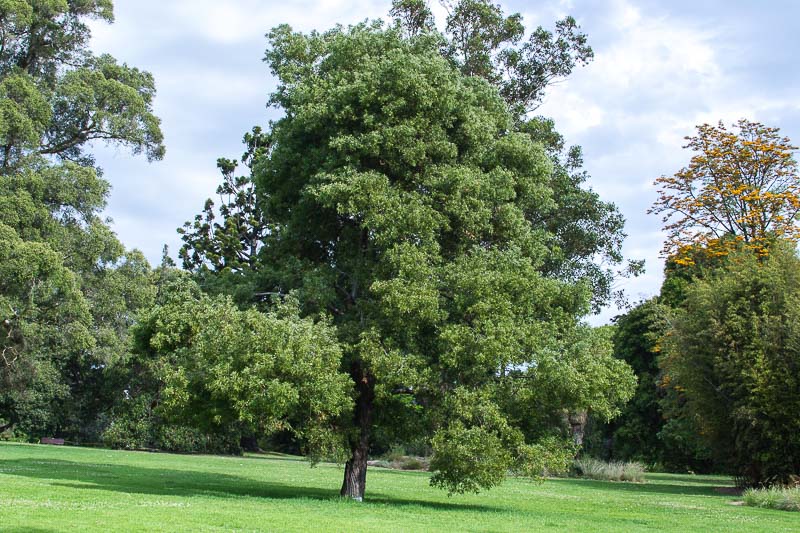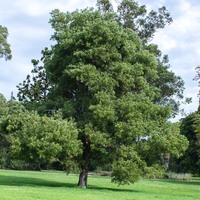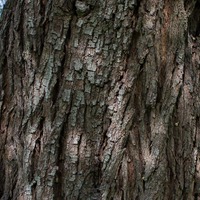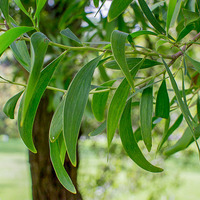Common name: Australian blackwood
Other common names: Blackwood
Description
Australian blackwood is a timber tree originating in Australia. Its native range extends from Tasmania and the southeastern corner of the Australian mainland, north along the eastern seaboard to the subtropics.
However, trees adapted to temperate and subtropical climates are treated as distinct varieties because of variation in their form, climate adaptation and tolerances. This description only includes those varieties adapted to areas with subtropical climates.
It may be up to 24 m (80 ft) in natural forests, though on open sites is more typically 10 to 20 m (30 to 65 ft) tall and grows at a slow to moderate rate, depending on the growing conditions, forming a straight trunk supporting a densely branched pyramidal or rounded crown. The bark is dark grey, rough and fissured.
The leaves on young trees are delicate and showy, consisting of numerous small blue-green leaflets in a feathery arrangement. They are replaced as the tree ages with less striking, dull green, sickle- or lance-shaped leaves.
The flowers are creamy-white to pale yellow puffballs that bloom from late winter to spring, sometimes with light blooms on and off throughout the year. They give off a sweet fragrance that reminds of honey and are followed by numerous small, flat, twisted or tightly coiled seedpods that become brown when mature, usually from summer to autumn.

Use
Australian blackwood is a major timber tree much valued for its golden brown to dark brown heartwood, made more decorative by reddish streaks and occasionally dark bands. Because of this, it is cultivated extensively in plantations across the world. The wood is medium-weight to heavy, averaging 600 to 700 kilograms per cubic meter (37 to 44 lbs per cubic ft), putting it in the hardwood class. However, it is only moderately resistant to rot and decay and is susceptible to wood-boring insects, limiting its outdoor use.
It is used in light construction, interior joinery, and for making high-end furniture, cabinets, and stringed musical instruments. Its natural resonance makes it ideally suited to this latter purpose. Selected roundwood lengths are sliced for decorative veneer, pulped for making composite woods, such as plywood, and cut for poles, posts, firewood, and charcoal.
Australian blackwood is widely cultivated as an ornamental tree in Australia for its shapely form, showy juvenile foliage, sweetly fragrant flowers, and shade.
Climate
Grows naturally in sub-humid to moderately humid subtropical and tropical mid- to high-elevation climates, generally areas with annual lows of 10 to 19°C, annual highs of 22 to 30°C, annual rainfall of 800 to 1500 mm and a dry season of 6 months or less. However, it has been grown successfully in areas with up to 2700 mm annual rainfall.
Growing
New plants are usually started from seed. Scaring or boiling the seed in water for about a minute improves germination. Most seed germinate within a week of planting.
Performs best on rich, free-draining clay and loam soils of a moderately acid to neutral nature, generally with a pH of 5.0 to 7.5, and on sites with full to partial sun exposure.
Established trees are generally unaffected by low salinity, or the equivalent of up to 2.5 grams of dissolved salt per litre of water (around one-fourteenth of the salinity of seawater).
Problem features
The tree produces abundant seed that germinate readily. It is listed as a weed in more than one reference publication and is assessed to be a high weed risk species for Hawaii by the Hawaii Pacific Weed Risk Assessment (HPWRA) project.
The roots are moderately vigorous, and a minimum planting distance of six meters away from any underground pipes is recommended. Root suckering is another problem feature of this tree species.
Where it grows
References
Books
-
Allen, O. N. & Allen, E. K. 1981, The Leguminosae : a source book of characteristics, uses, and nodulation, University of Wisconsin Press, Madison, Wisconsin
-
Boland, D. & Brooker, I. & McDonald, M. W. 2006, Forest trees of Australia, 5th ed., CSIRO Publishing (Ensis), Melbourne
-
Bristow, M. & Bragg, A. & Annandale. M. 2005, Growing rainforest timber trees: a farm forestry manual for north Queensland, Research and Development Corporation (RIRDC), Barton, A.C.T, Australia
-
C.A.B. International 2013, The CABI encyclopedia of forest trees, CABI Publishing, Wallingford, Oxfordshire
-
Chudnoff, M. 1984, Tropical timbers of the world, Forest Service, U.S. Department of Agriculture (USDA), Washington, D.C.
-
Church, G. & Greenfield, P. 2002, Trees and shrubs for fragrance, David Bateman, Auckland, New Zealand
-
Doran, J. C & Turnbull, J. W. 1997, Australian trees and shrubs : species for land rehabilitation and farm planting in the tropics, 2nd ed, Australian Centre for International Agricultural Research (ACIAR), Canberra, Australian Capital Territory
-
Holliday, I. 2002, A field guide to Australian trees, 3rd revised editon, New Holland Publishers, Frenchs Forest, New South Wales
-
Lake, M. 2015, Australian rainforest woods : characteristics, uses and identification, CSIRO Publishing, Collingwood, Victoria
-
Lemmens, R.H.M.J., Louppe, D. & Oteng-Amoako, A.A. (eds). PROTA, Plant Resources of Tropical Africa, Volume 7(1) : Timbers 1, PROTA Foundation, Backhuys Publishers, Leiden
-
Little, E. L. & Skolmen, R. G. 1989, Common forest trees of Hawaii (native and introduced), Agricultuural Handbook No. 679, Forest Service, U.S. Department of Agriculture, Washington, D.C.
-
Luna, R. K 1996, Plantation trees, International Book Distributors, Dehradun, Uttarakhand
-
Macmillan, H. F. 1943, Tropical planting and gardening : with special reference to Ceylon, 5th ed, Macmillan Publishing, London
-
Marcar, N. E. 1995, Trees for saltland : a guide to selecting native species for Australia, Division of Forestry, Commonwealth Scientific and Industrial Research Organisation (CSIRO) Australia, Canberra
-
Porter, T. 2012, Wood : identification & use, Compact edition, Guild of Master Craftsman Publications, Lewes, East Sussex
-
Scheffer, T. C & Morrell, J. J. 1998, Natural durability of wood : a worldwide checklist of species, Forest Research Laboratory, Oregon State University, Corvallis, Oregon
-
Streets, R. J. & Troup, R. S. 1962, Exotic forest trees in the British Commonwealth, Oxford University Press, Oxford, England
-
Webb, D. B. 1984, A Guide to species selection for tropical and sub-tropical plantations, 2nd ed., Unit of Tropical Silviculture, Commonwealth Forestry Institute, University of Oxford, Oxfordshire
Articles, Journals, Reports and Working Papers
-
South East Water Company 1999, Tree roots : a growing problem, South East Water, Moorabbin, Victoria




